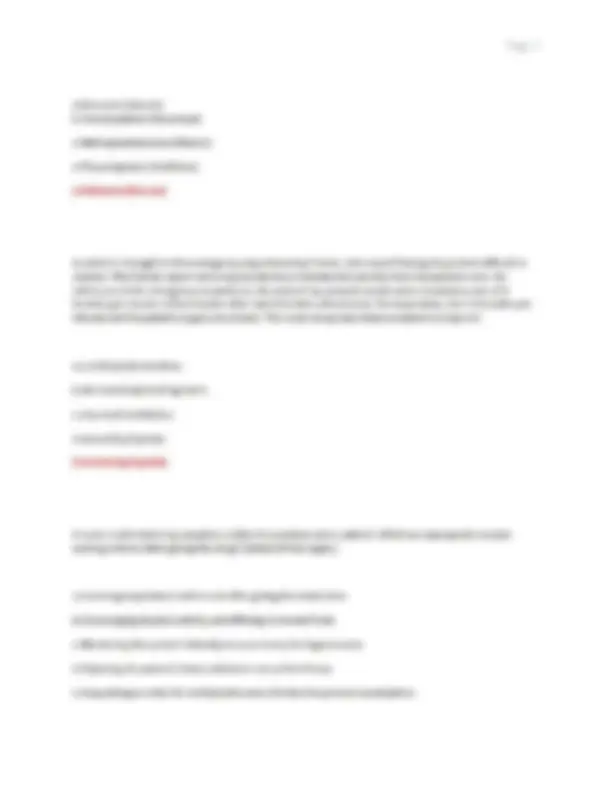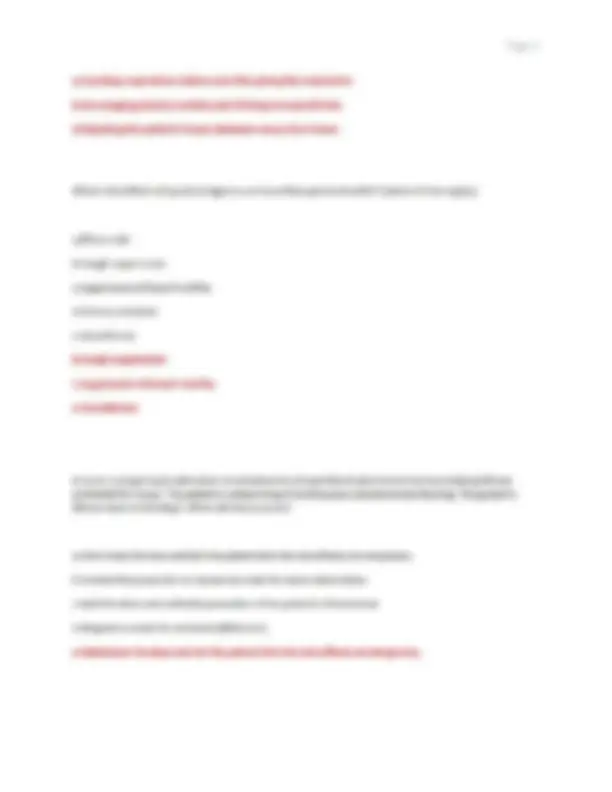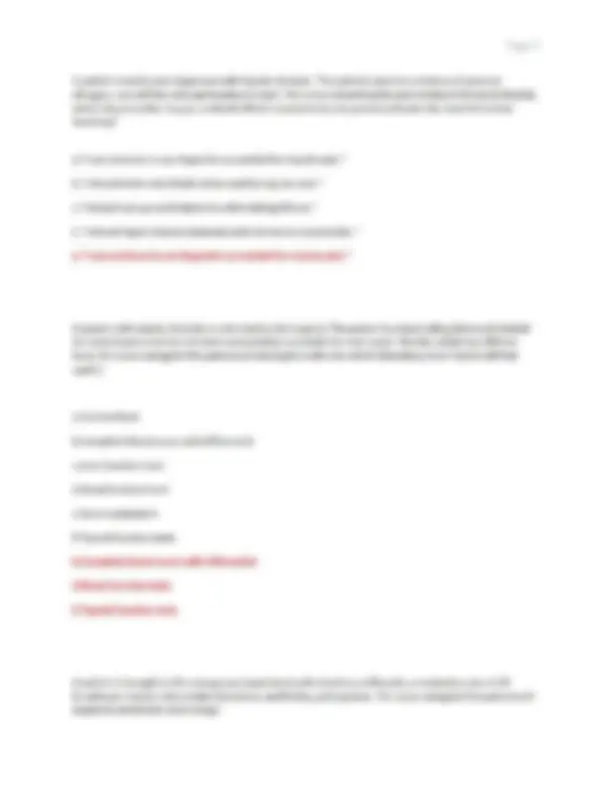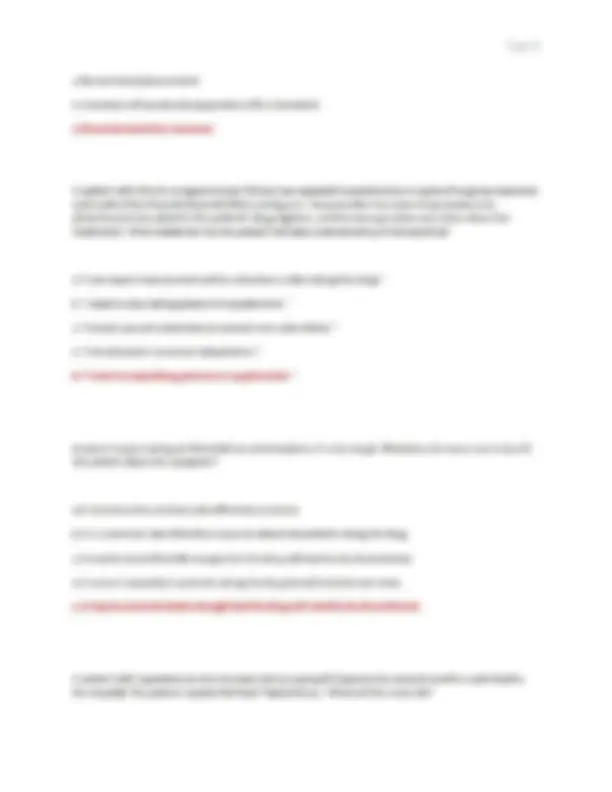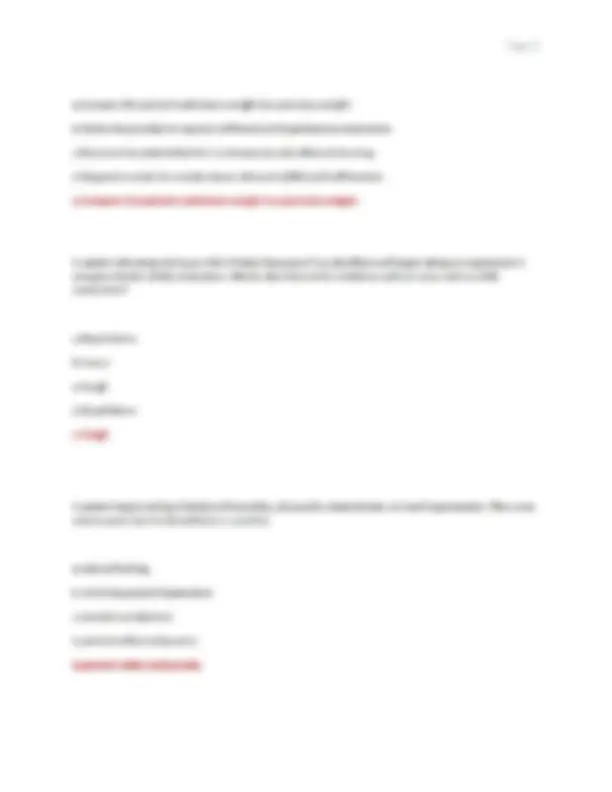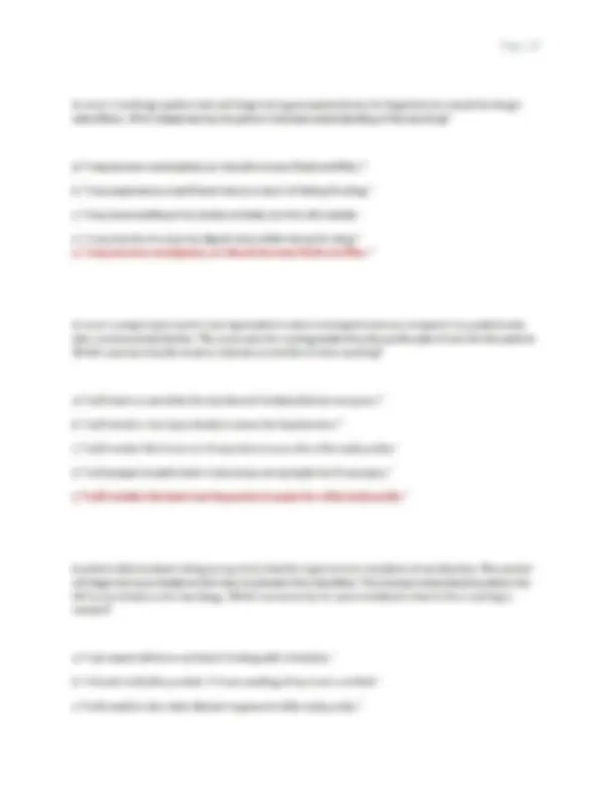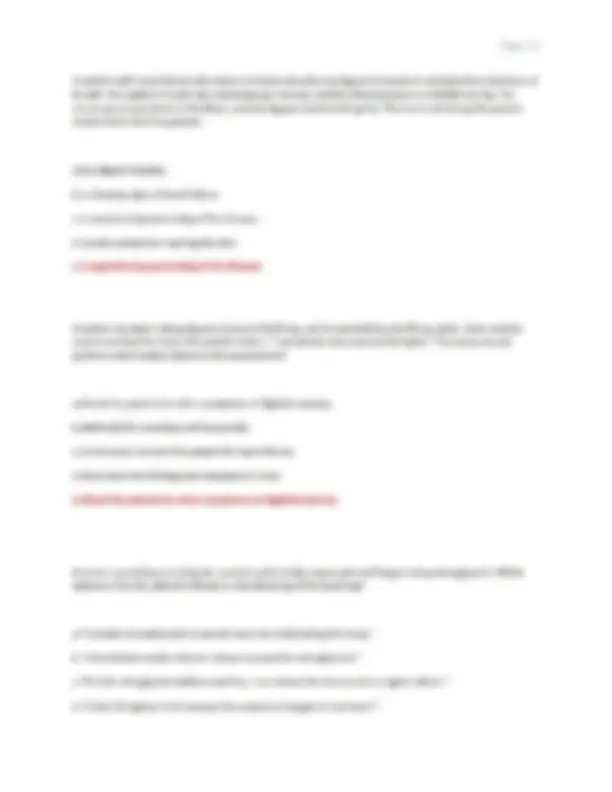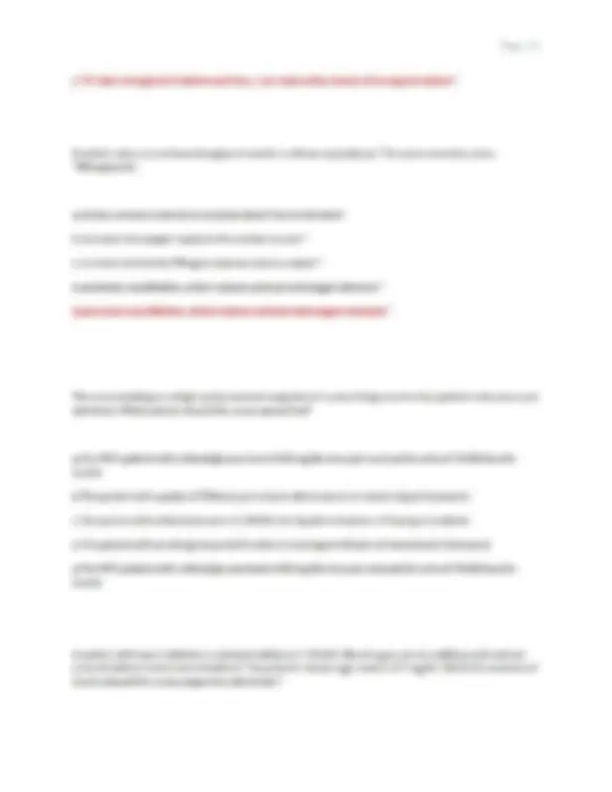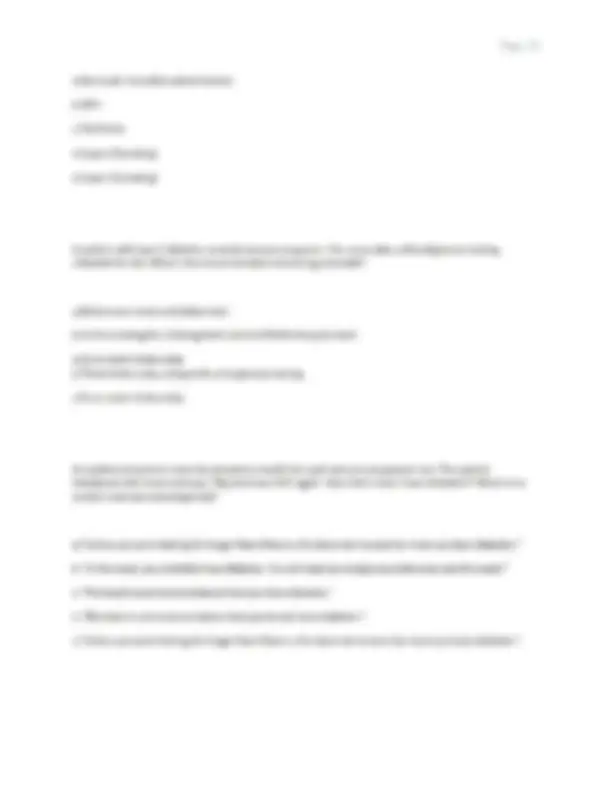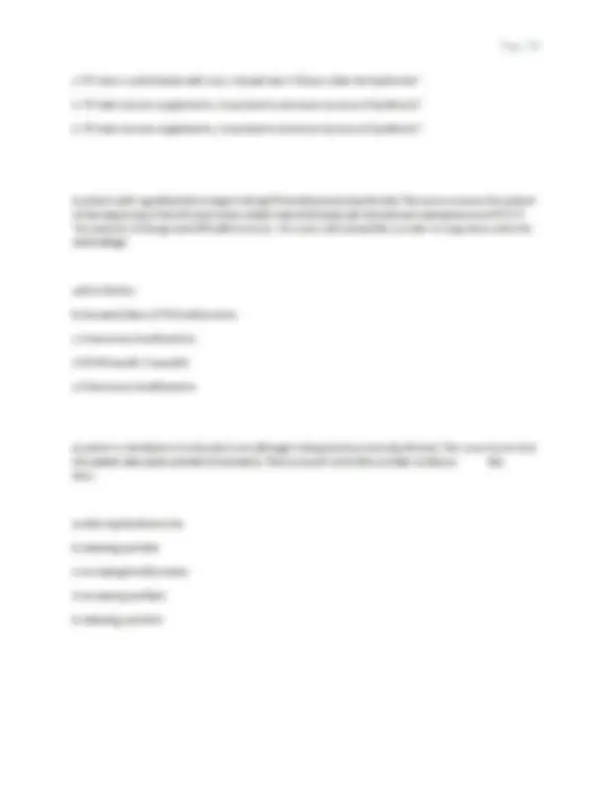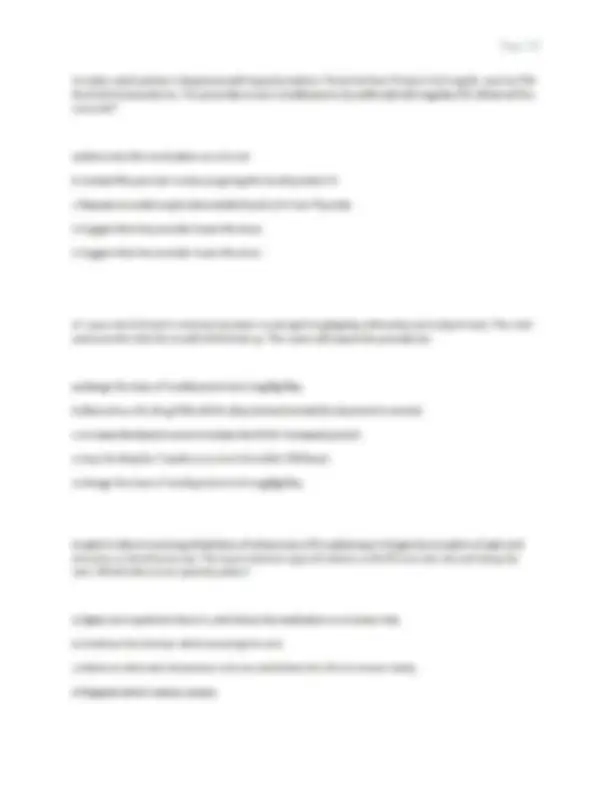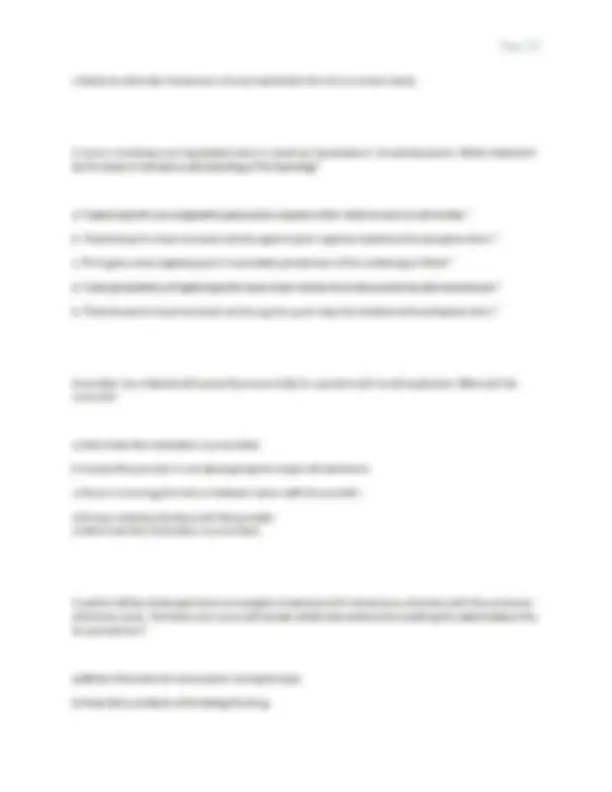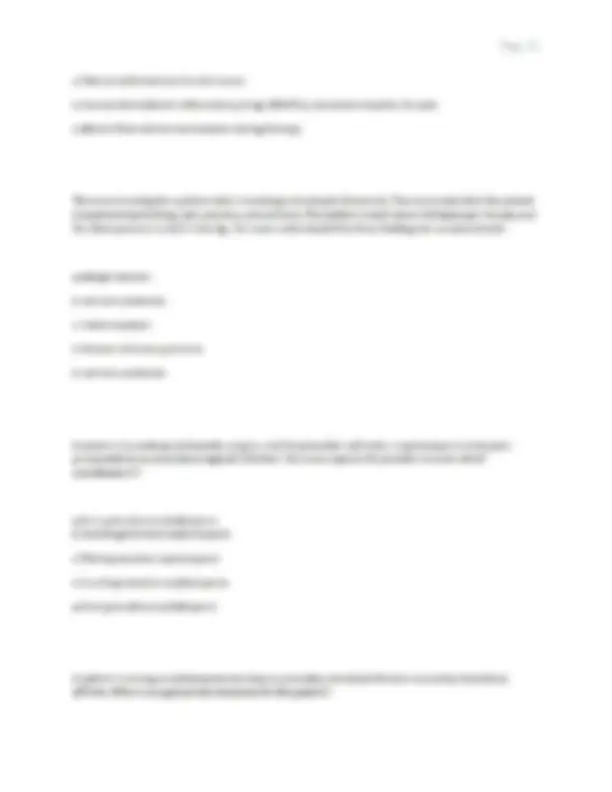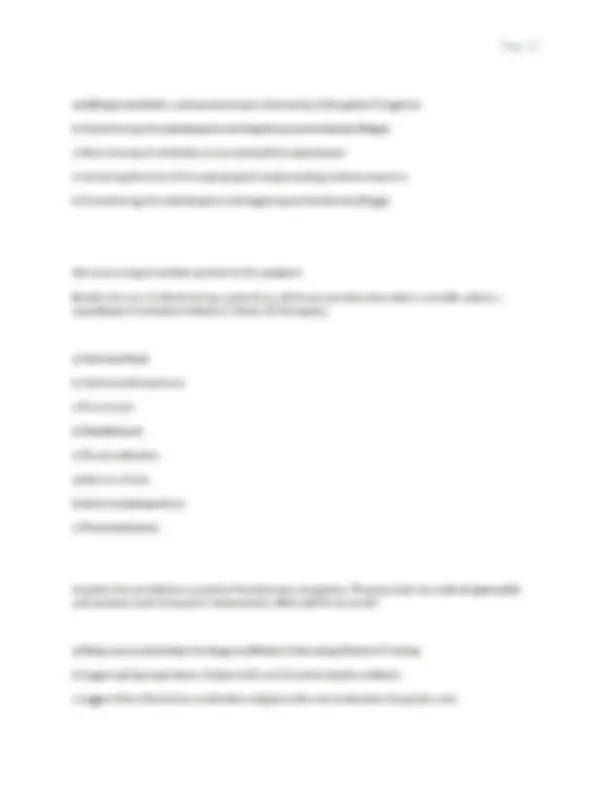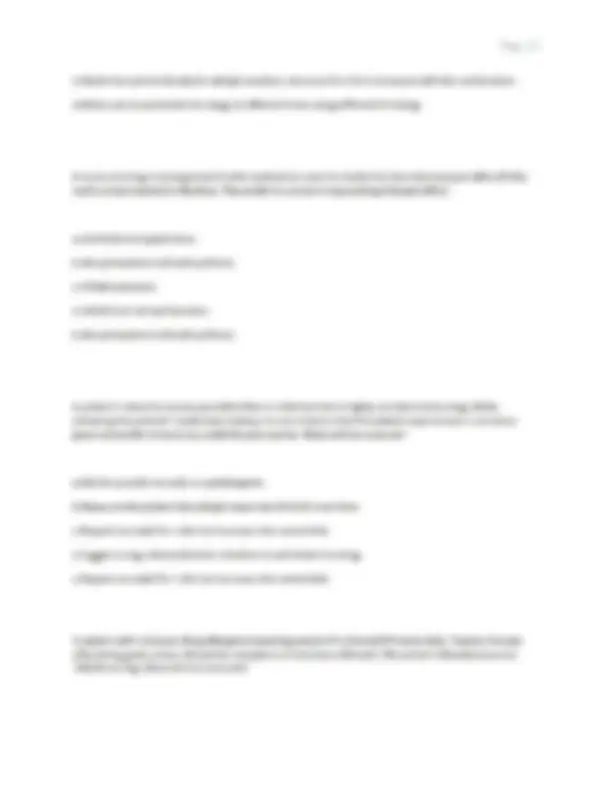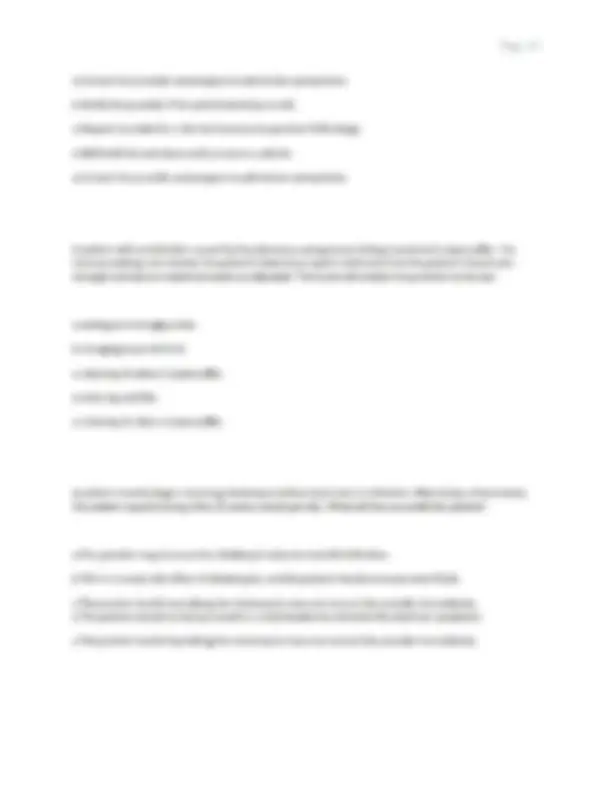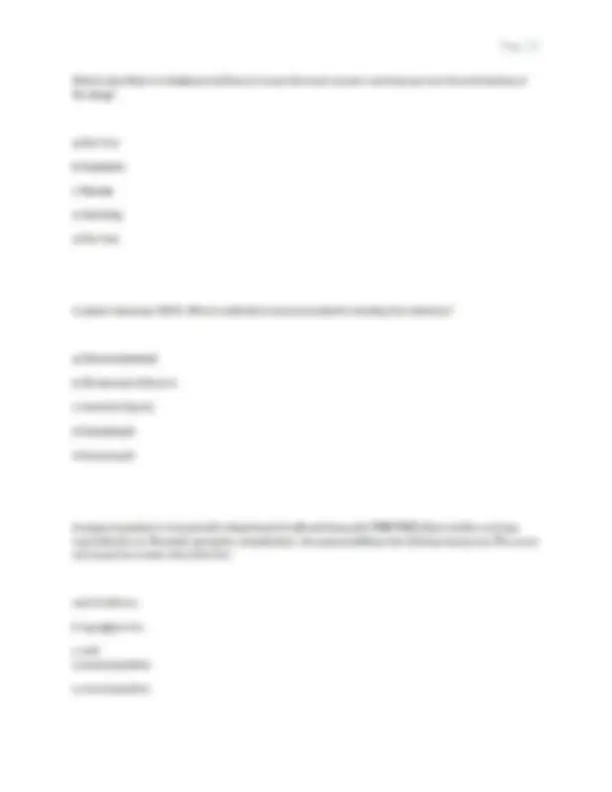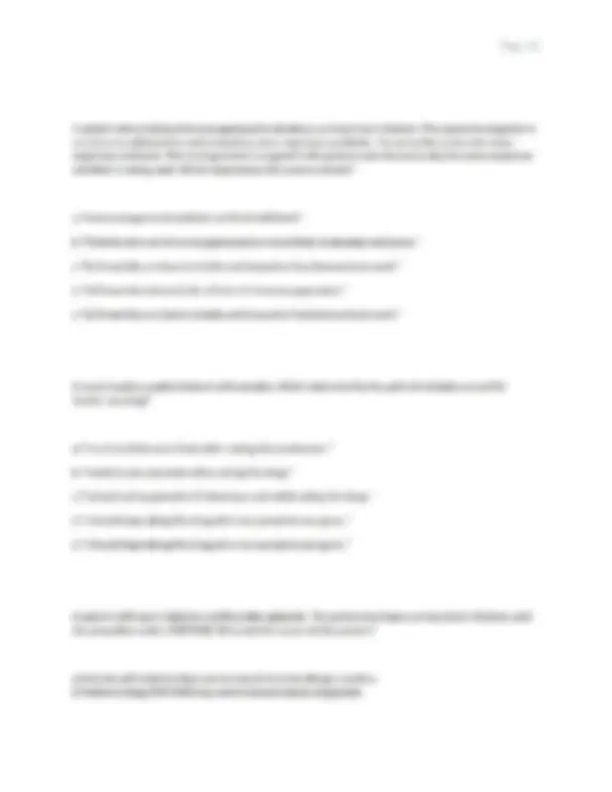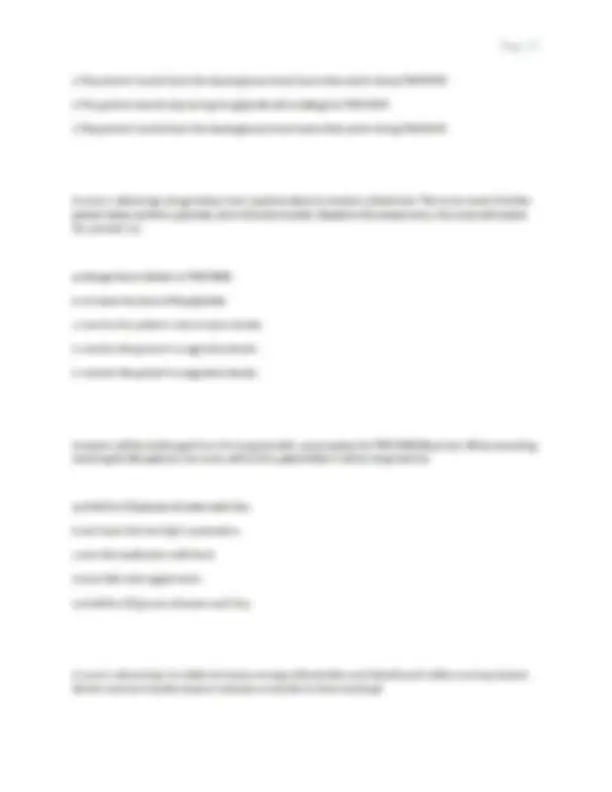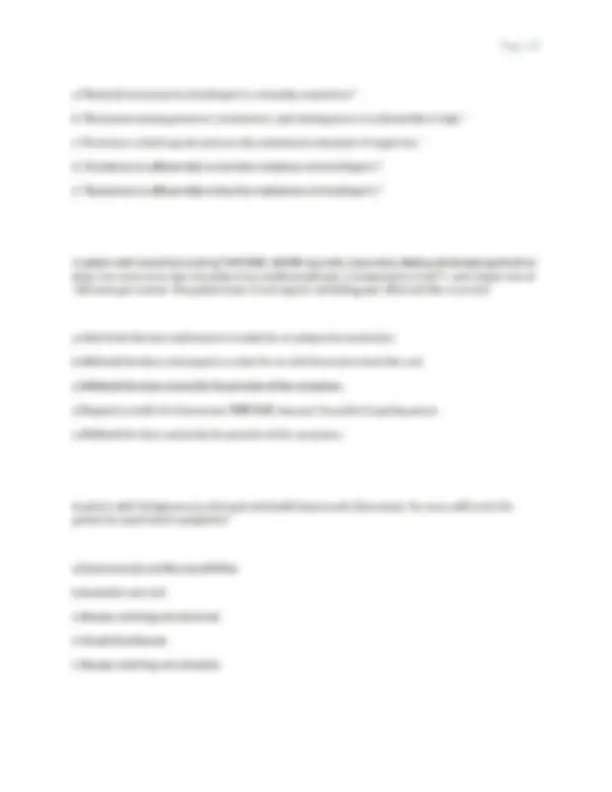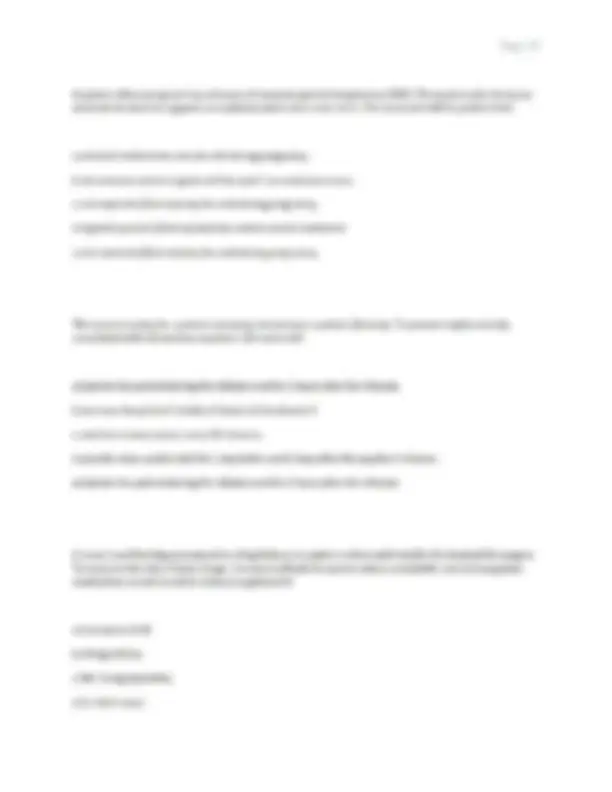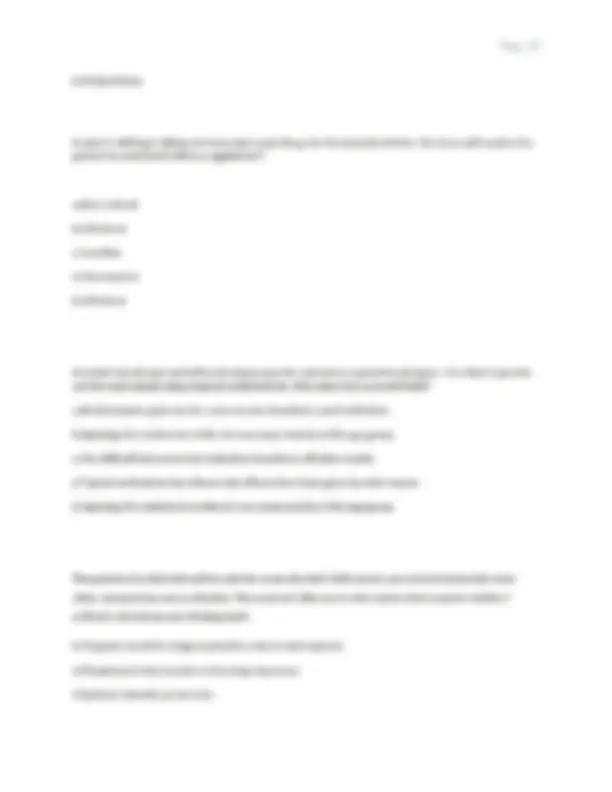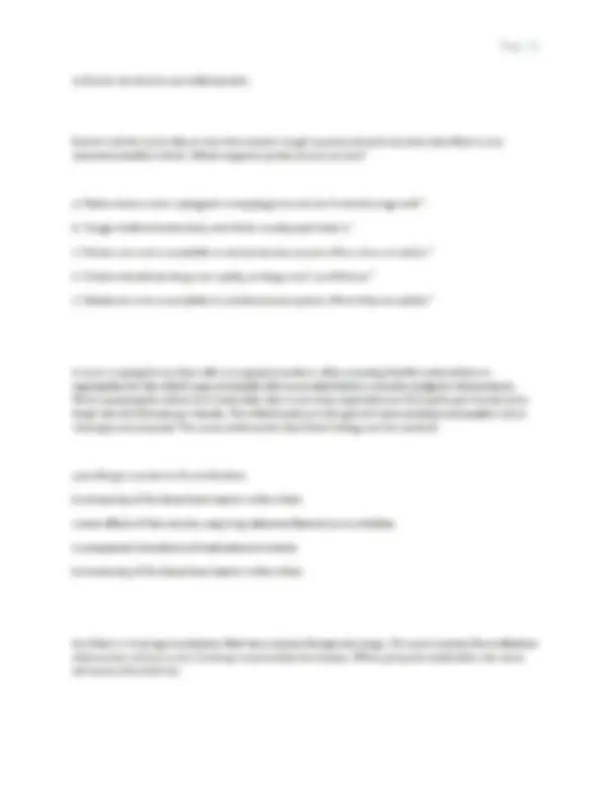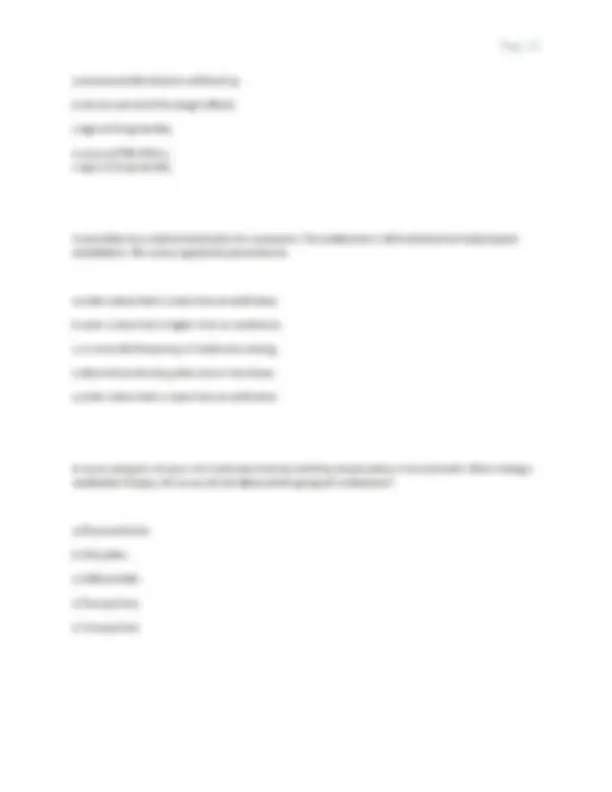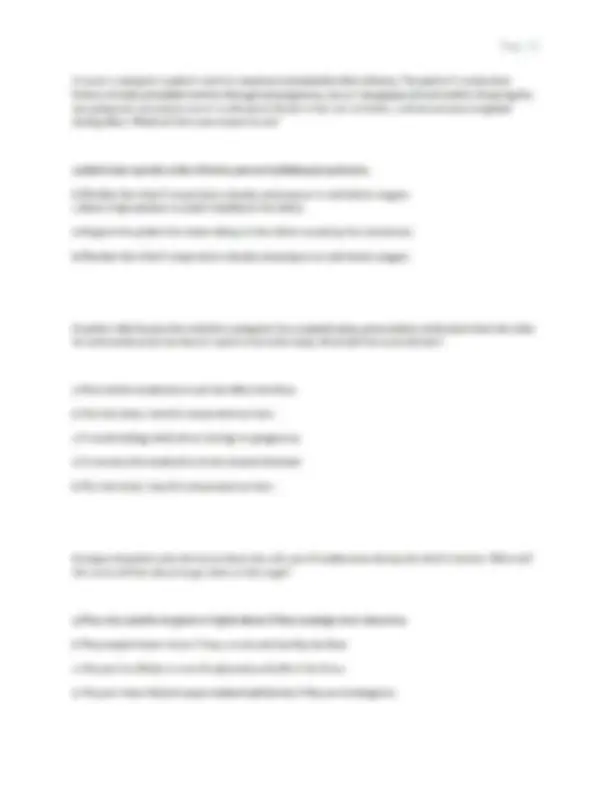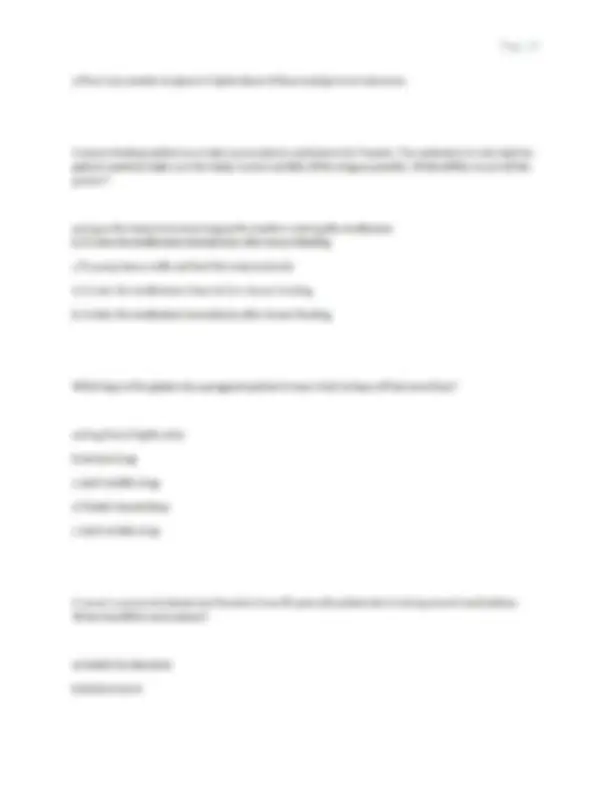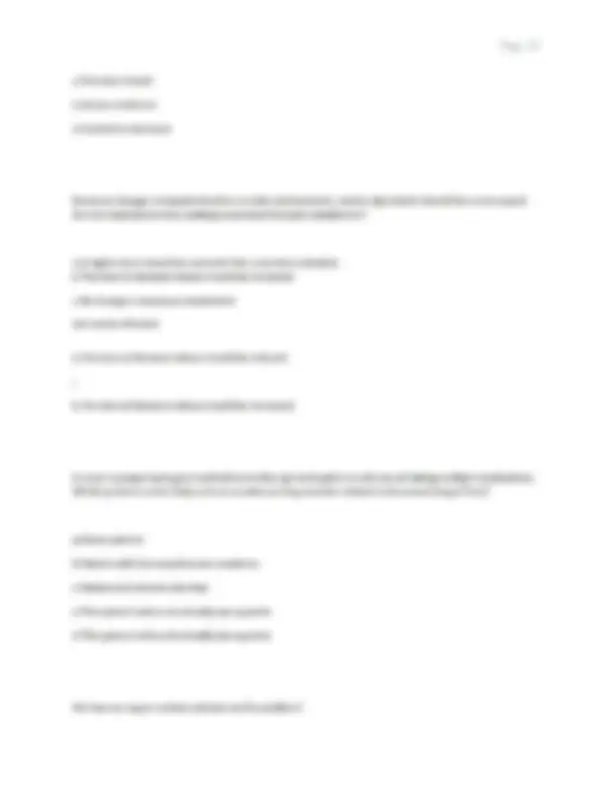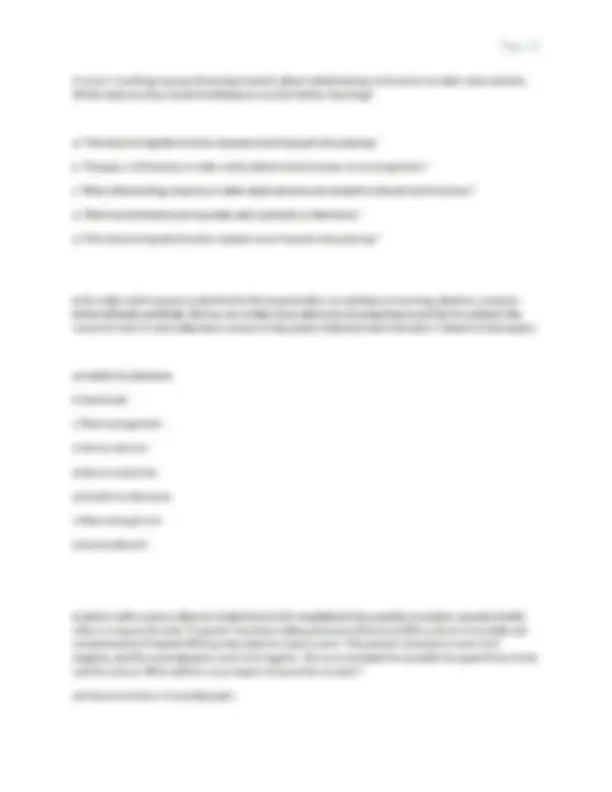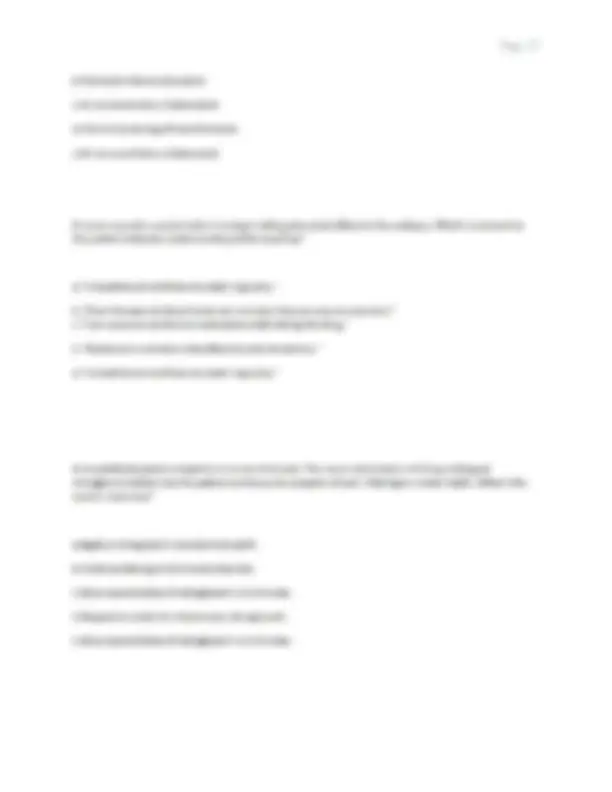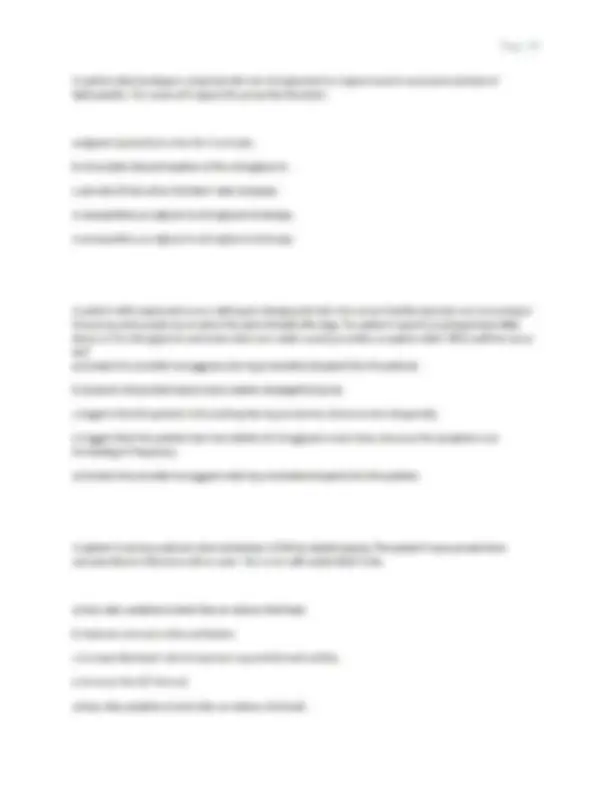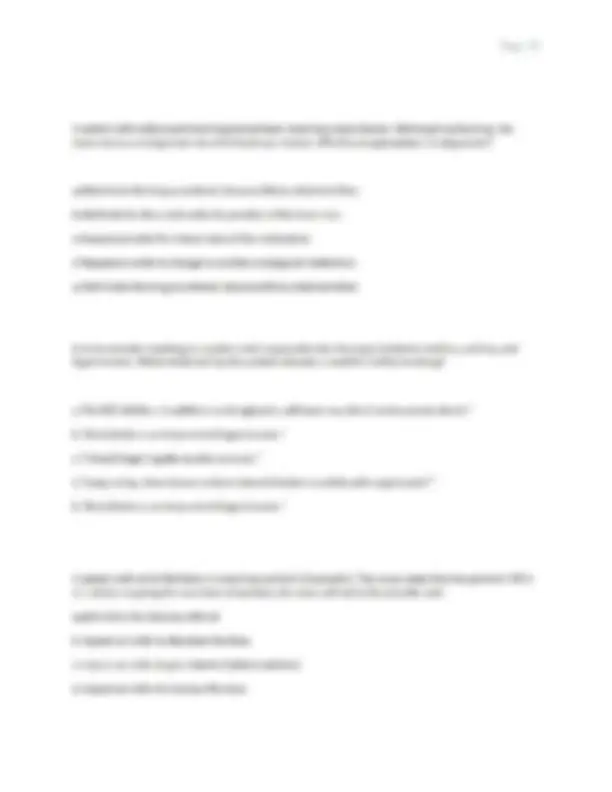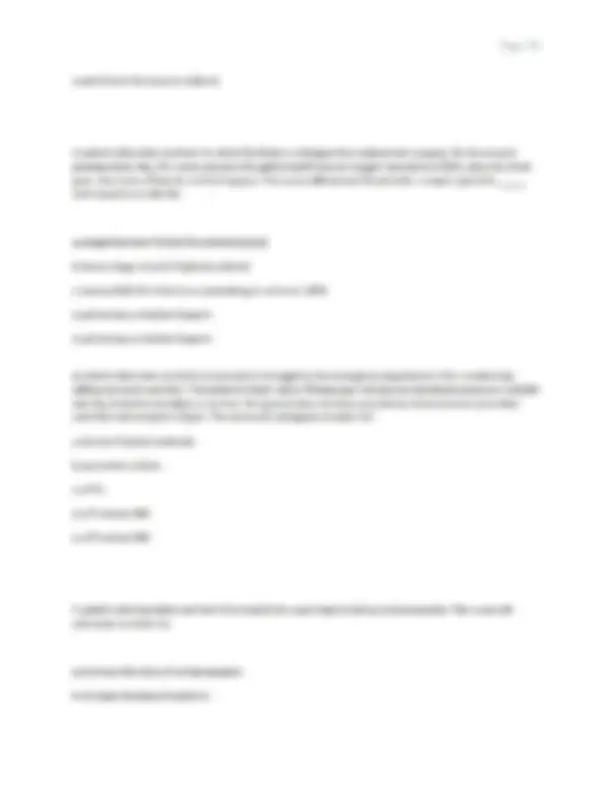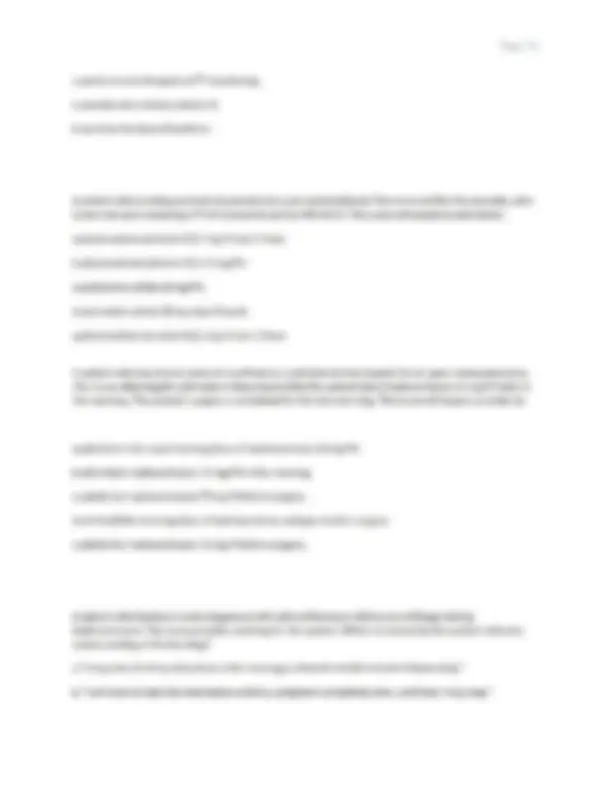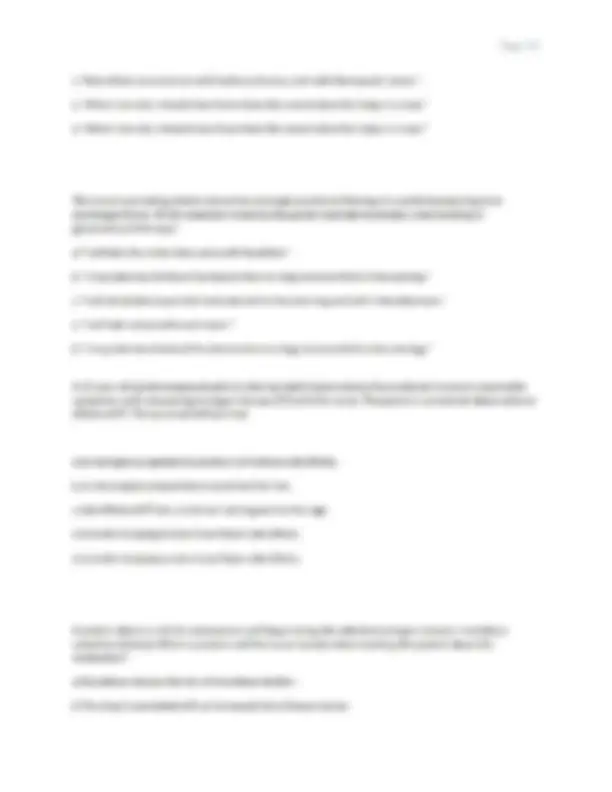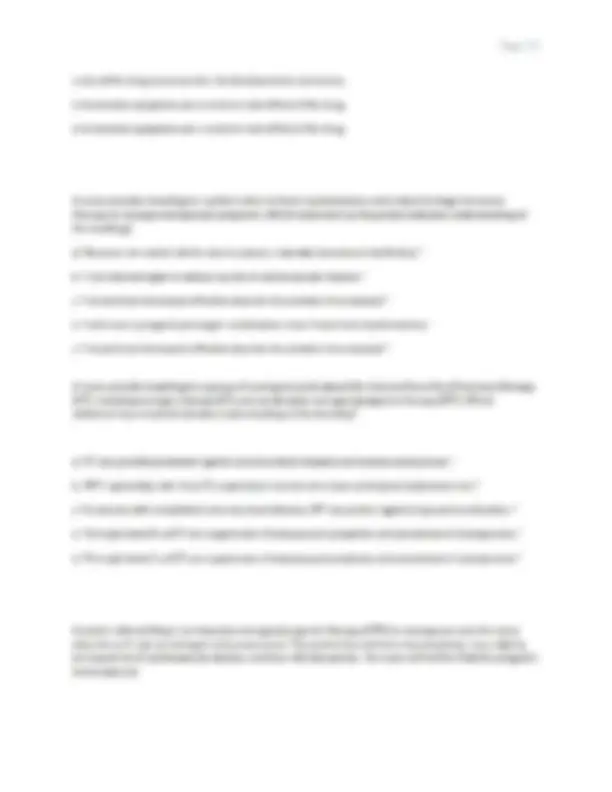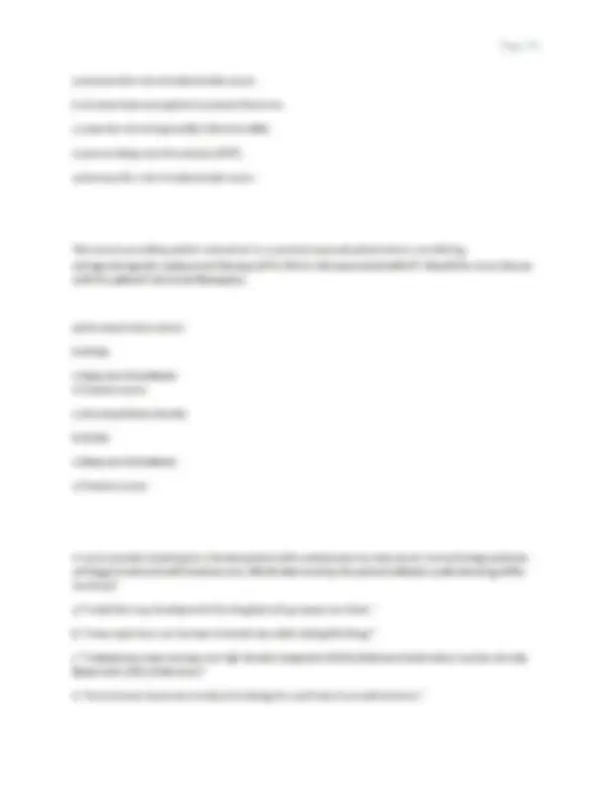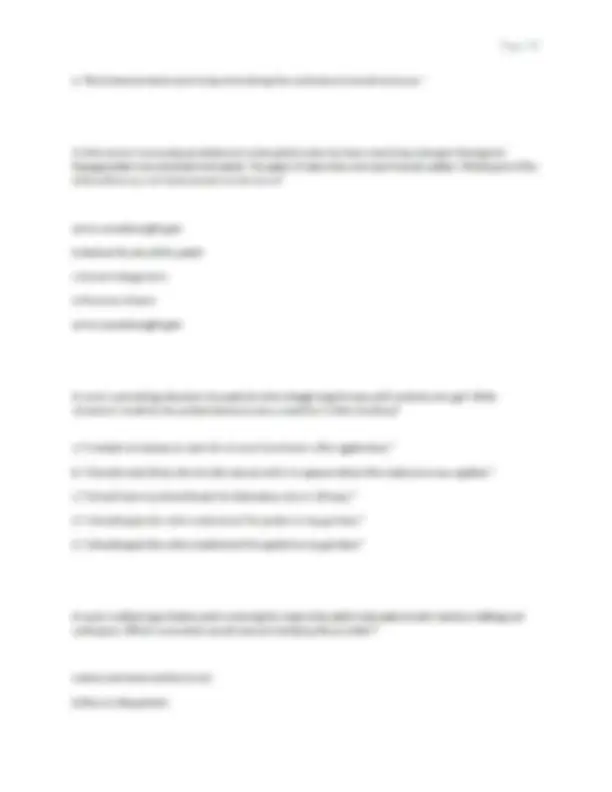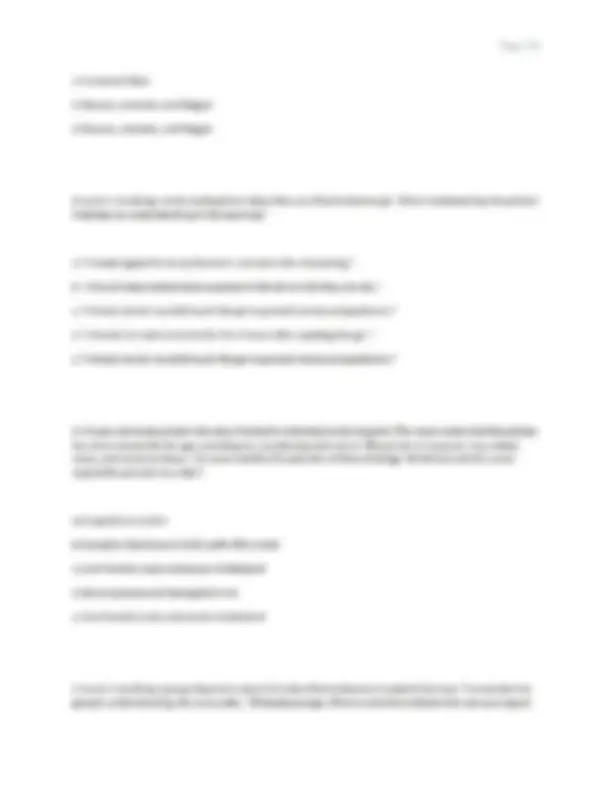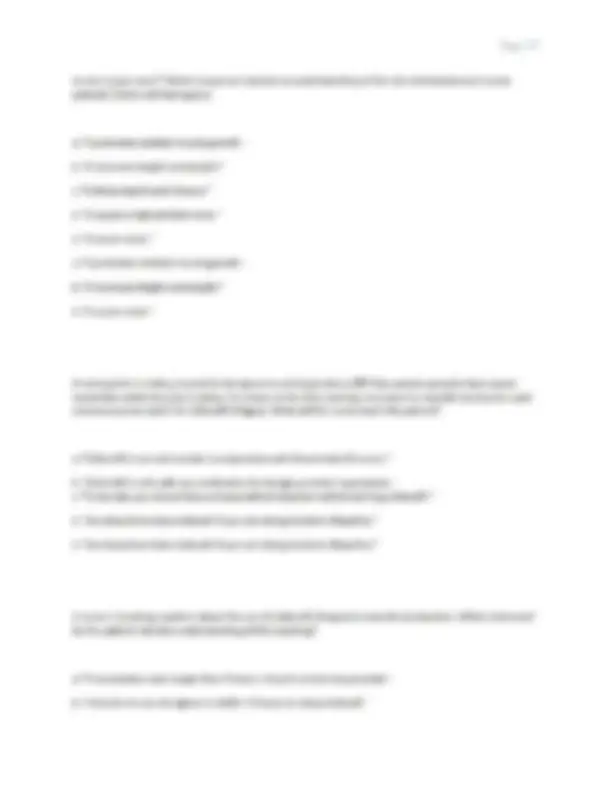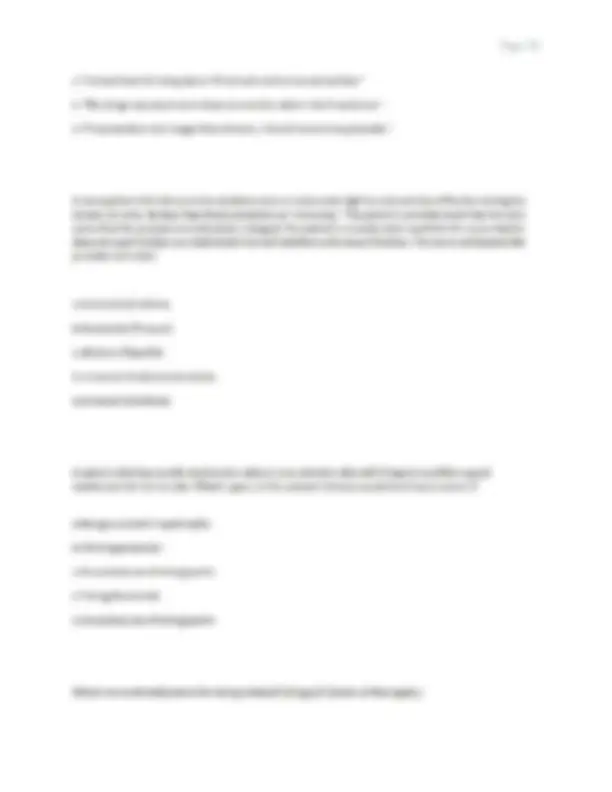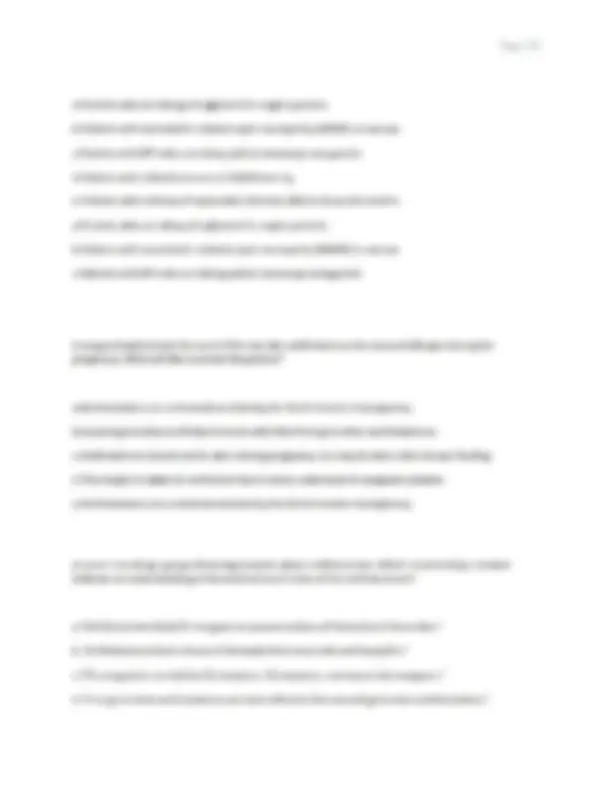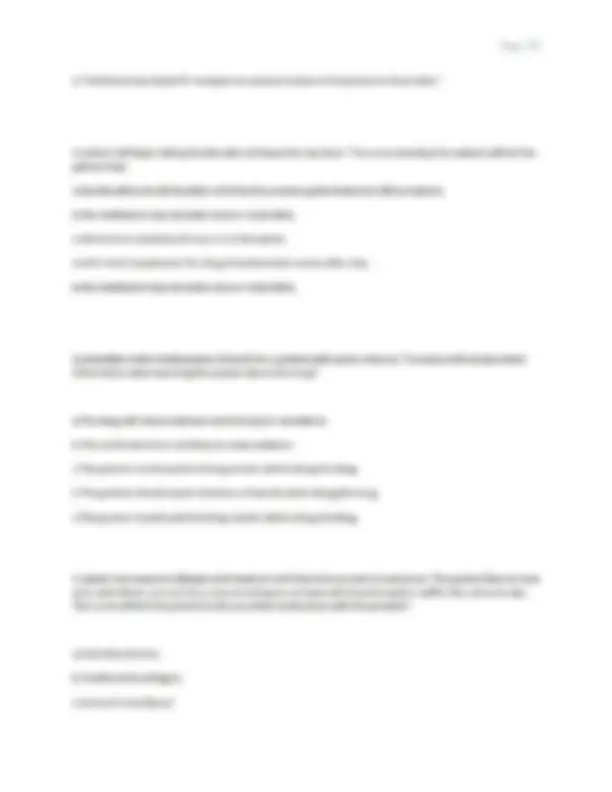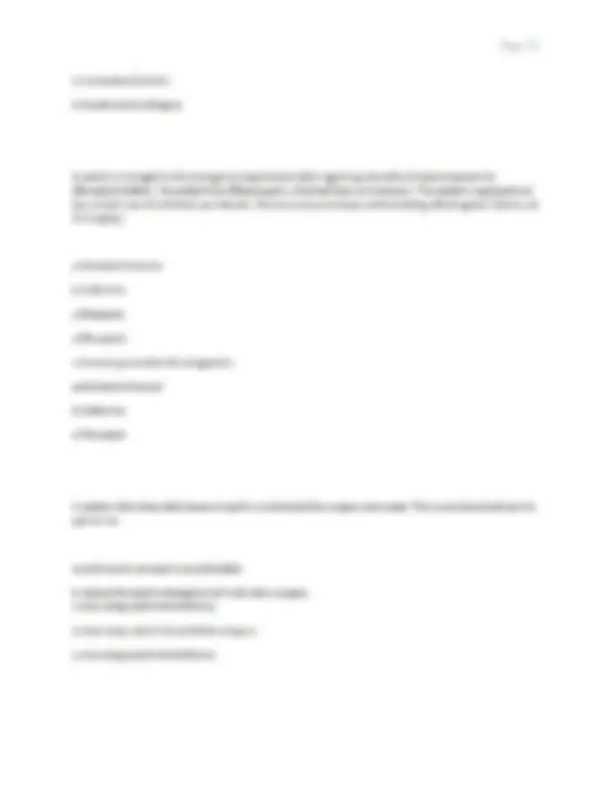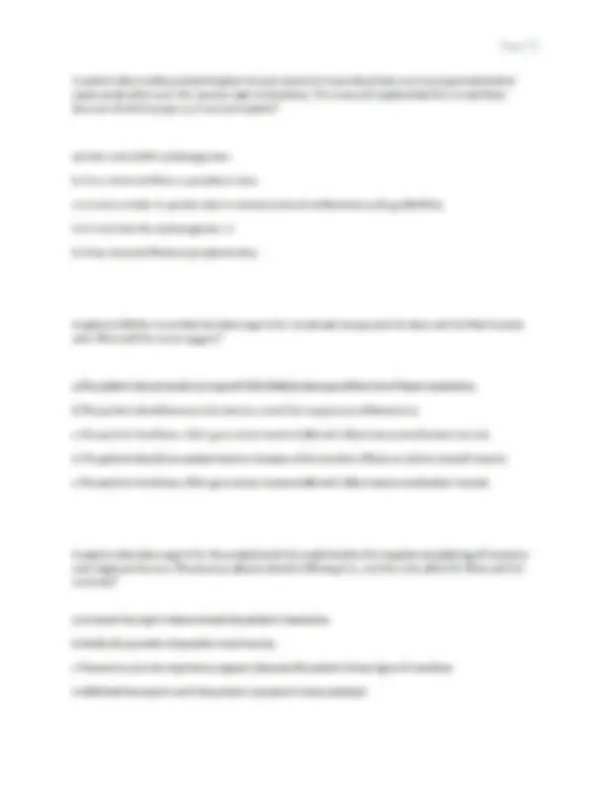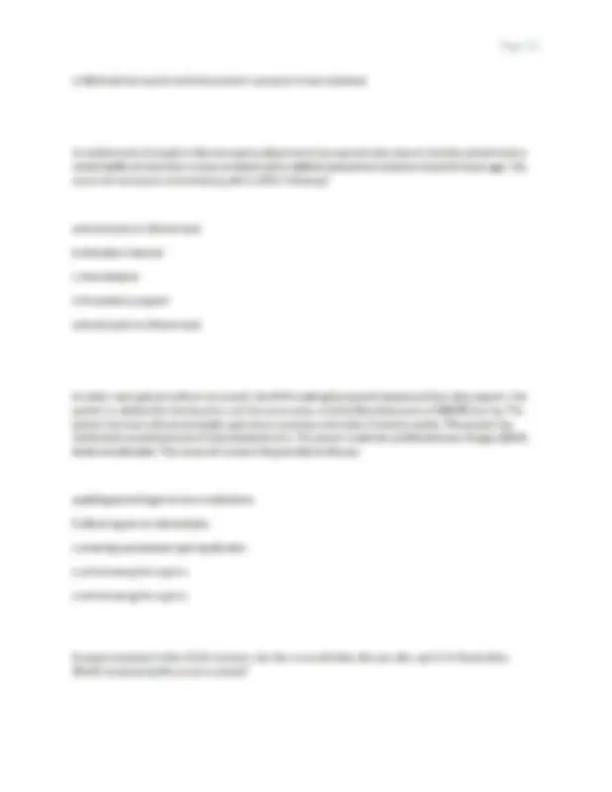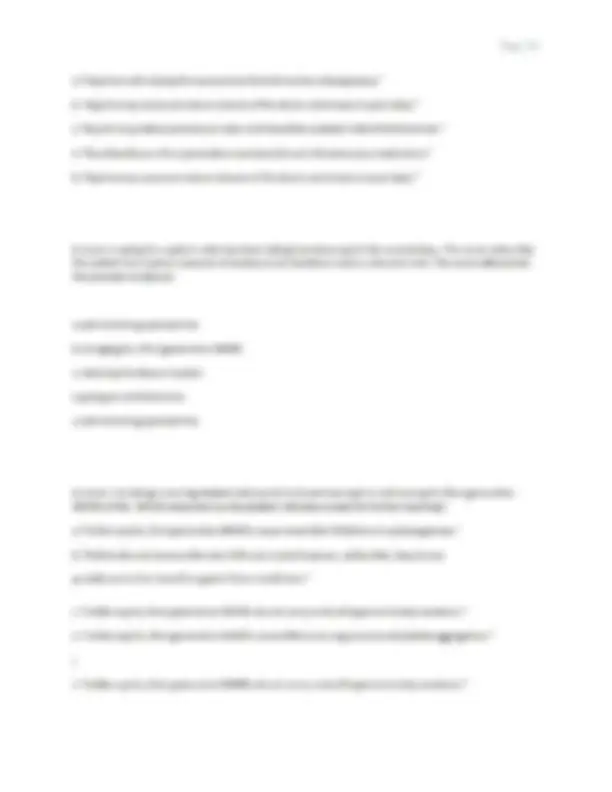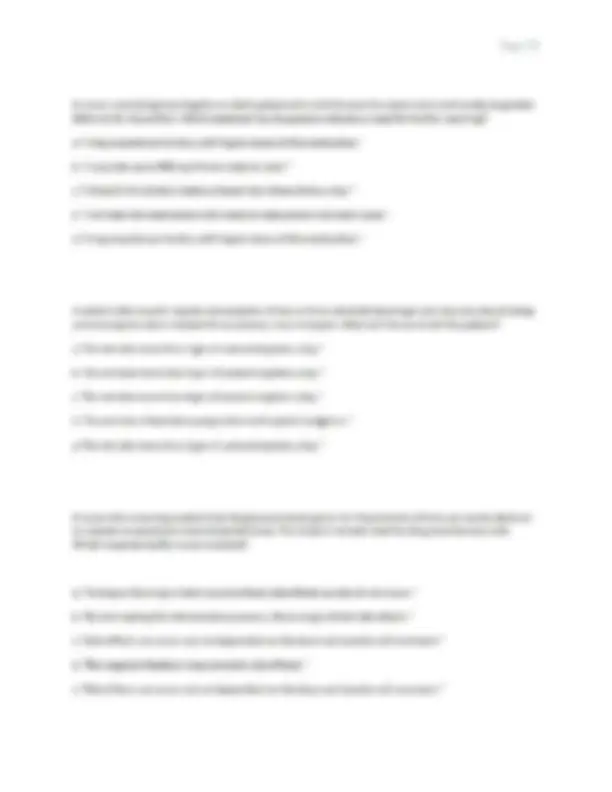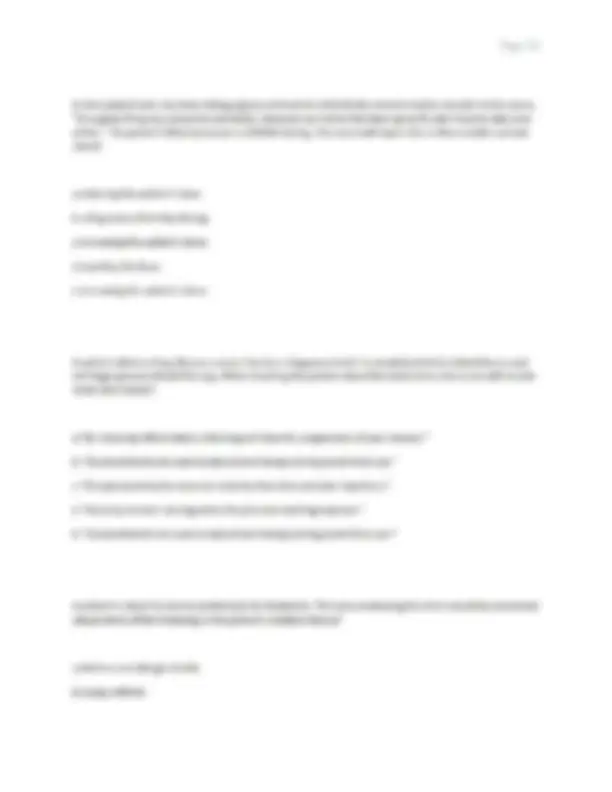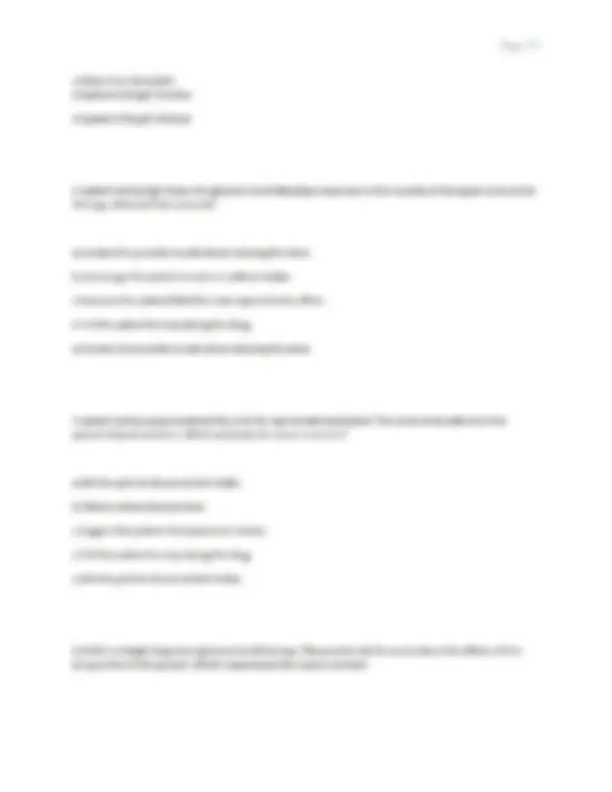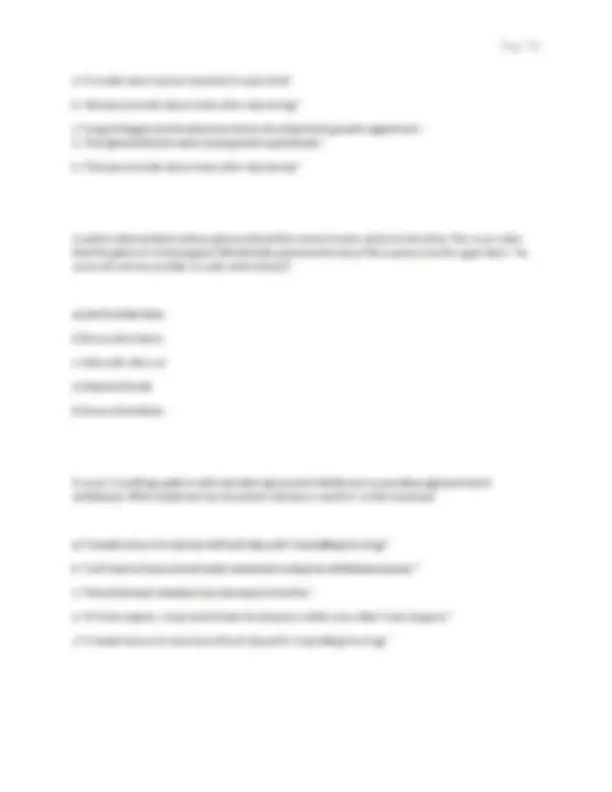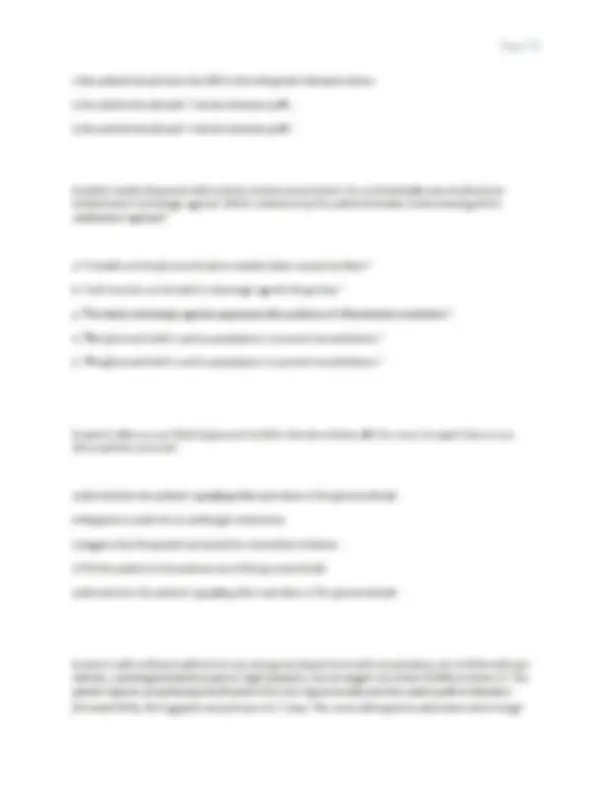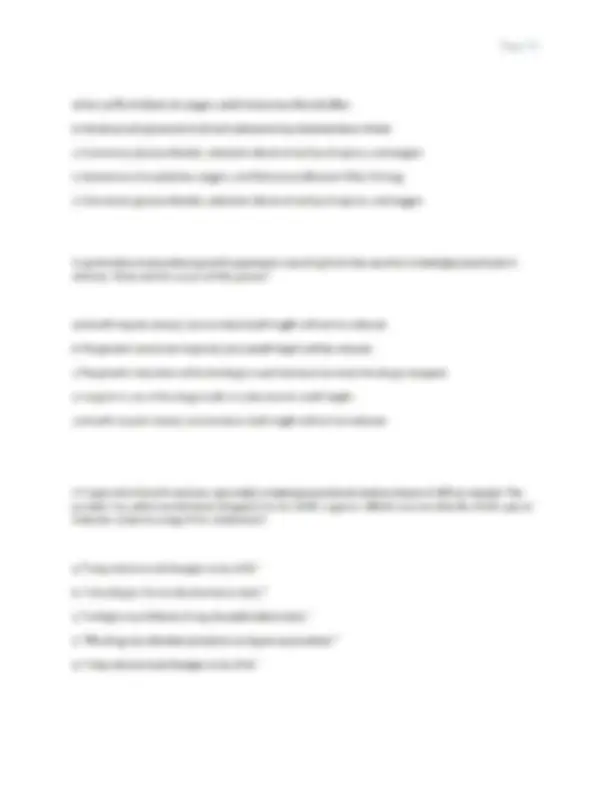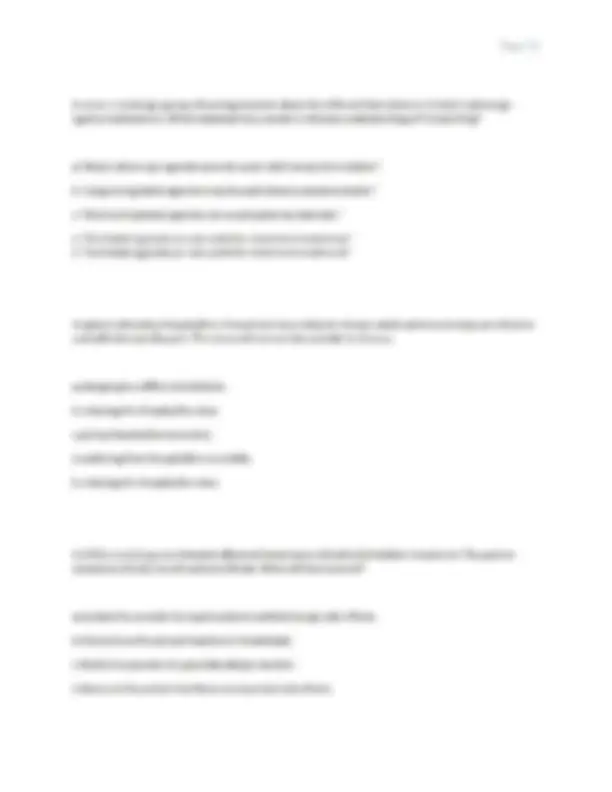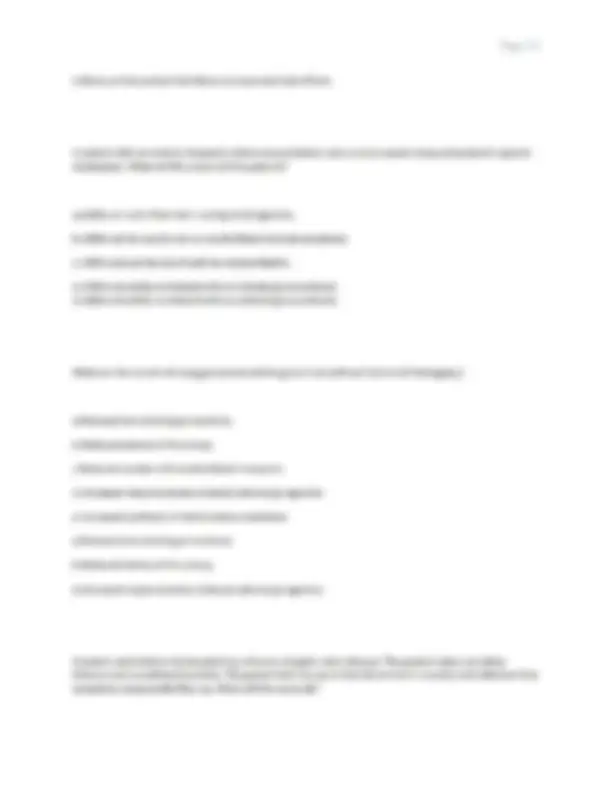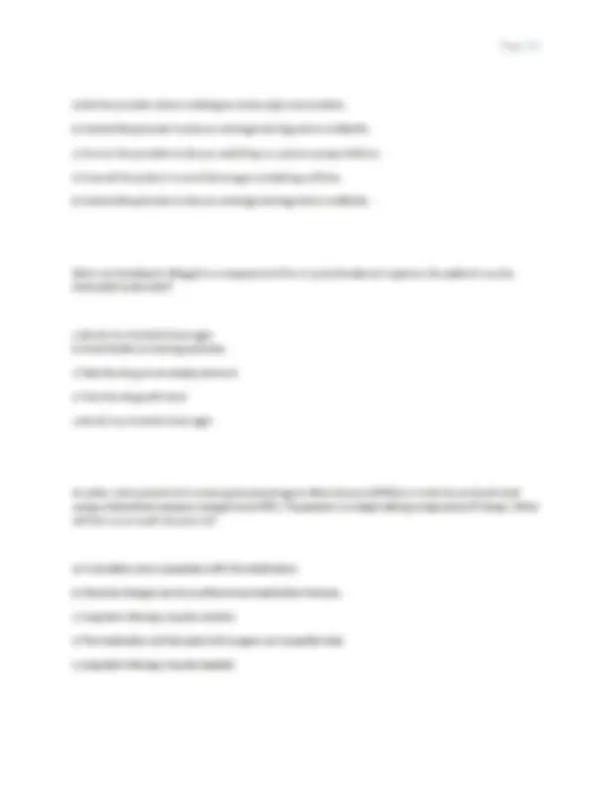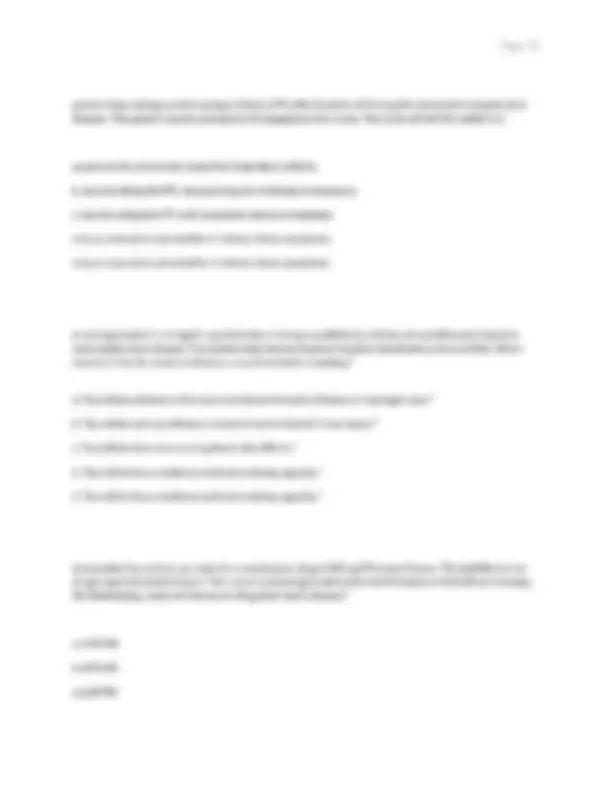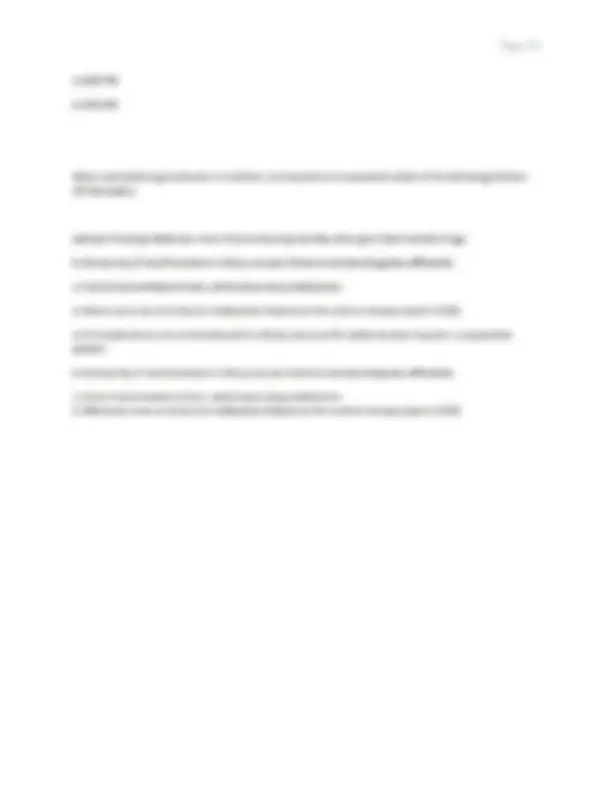Partial preview of the text
Download Nur2474 Pharmacology Final Exam Nclex Style Practice 2025-Answered and more Exams Pharmacology in PDF only on Docsity!
A patient is to begin taking phenytoin (Dilantin) for seizures. The patient tells the nurse that she is taking oral contraceptives. What will the nurse tell the patient? a.She may need to increase her dose of phenytoin while taking oral contraceptives. b.She should consider a different form of birth control while taking phenytoin. c.She should remain on oral contraceptives, because phenytoin causes birth defects. d.She should stop taking oral contraceptives, because they reduce the effectiveness of phenytoin. b.She should consider a different form of birth control while taking phenytoin. Anurse is completing a discharge plan for a 24-year-old patient who will begin taking phenytoin. Which information is important to teach this patient? a.She may stop taking the drug when she is seizure free for a year. b.Taking the medication will ensure that she no longer has seizures. c.She may need to discontinue the drug if serious side effects occur. d.She should be sure to use an effective contraceptive method. d.She should be sure to use an effective contraceptive method. A patient who has had abdominal surgery has been receiving morphine sulfate via a patient-controlled analgesia (PCA) pump. The nurse assesses the patient and notes that the patient's pupils are dilated and that the patient is drowsy and lethargic. The patient's heart rate is 84 beats per minute, the respiratory rate is 10 breaths per minute, and the blood pressure is 90/50 mm Hg. What will the nurse do? a.Discuss possible opiate dependence with the patient's provider. b.Encourage the patient to turn over and cough and take deep breaths. c.Note the effectiveness of the analgesia in the patient's chart. d.Prepare to administer naloxone and possibly ventilatory support. d.Prepare to administer naloxone and possibly ventilatory support A patient with cancer has been taking an opioid analgesic four times daily for several months and reports needing increased doses for pain. What will the nurse tell the patient? a.PRN dosing of the drug may be more effective. b.The risk of respiratory depression increases over time. c.The patient should discuss increasing the dose with the provider. d.The patient should request the addition of a benzodiazepine to augment pain relief. c.The patient should discuss increasing the dose with the provider. Awoman in labor receives meperidine (Demerol) for pain. The nurse caring for the infant will observe the infant closely for: a.congenital anomalies. b.excessive crying and sneezing. c.respiratory depression. d.tremors and hyperreflexia. c.respiratory depression. A postoperative patient has received an epidural infusion of morphine sulfate. The patient's respiratory rate decreases to 8 breaths per minute, and he has a decreased level of consciousness and miosis. Which medication would the nurse anticipate administering? a.Counting respirations before and after giving the medication b.Encouraging physical activity and offering increased fluids d.Palpating the patient's lower abdomen every 4 to 6 hours Which side effects of opioid analgesics can have therapeutic benefits? (Select all that apply.) a.Biliary colic b.Cough suppression c.Suppression of bowel motility d.Urinary retention e.Vasodilation b.Cough suppression c.Suppression of bowel motility e.Vasodilation Anurse is preparing to administer medications to a hospitalized patient who has been taking lithium (Lithobid) for 3 days. The patient is complaining of mild nausea and abdominal bloating. The patient's lithium level is 0.8 mEq/L. What will the nurse do? a.Administer the dose and tell the patient that the side effects are temporary. b.Contact the prescriber to request an order for serum electrolytes. c.Hold the dose and notify the prescriber of the patient's lithium level. d.Request an order for amiloride (Midamor). a.Administer the dose and tell the patient that the side effects are temporary. A patient recently was diagnosed with bipolar disorder. The patient, who has a history of seasonal allergies, is an athlete who participates in track. The nurse is teaching the patient about lithium (Lithobid), which the prescriber has just ordered. Which statement by the patient indicates the need for further teaching? a."Ican continue to use ibuprofen as needed for muscle pain." b."| should drink extra fluids before and during exercise." c."| should not use antihistamines while taking lithium." d."I should report muscle weakness and tremors to my provider." a."I can continue to use ibuprofen as needed for muscle pain." A patient with bipolar disorder is admitted to the hospital. The patient has been taking lithium (Lithobid) for several years and has not been evaluated by a provider for over a year. Besides obtaining a lithium level, the nurse caring for this patient will anticipate orders for which laboratory tests? (Select all that apply.) a.Calcium level b.Complete blood count with differential c.Liver function tests d.Renal function tests e.Serum potassium f.Thyroid function tests b.Complete blood count with differential d.Renal function tests f. Thyroid function tests A patient is brought to the emergency department with shortness of breath, a respiratory rate of 30 breaths per minute, intercostal retractions, and frothy, pink sputum. The nurse caring for this patient will expect to administer which drug? Anurse preparing to administer morning medications notes that a patient with a history of hypertension has been prescribed the angiotensin-converting enzyme (ACE) inhibitor captopril (Capoten) concurrently with spironolactone (Aldactone). Morning laboratory results reveal a serum sodium level of 144 mg/dL, a serum potassium level of 5.1 mEq/L, and a blood glucose level of 128 mg/dL. Which intervention is appropriate? a.Administer the medications as ordered. b.Ask the patient about the use of salt substitutes. c.Contact the provider to report the laboratory values. d.Request an order for furosemide (Lasix). c.Contact the provider to report the laboratory values. A patient is taking gentamicin (Garamycin) and furosemide (Lasix). The nurse should counsel this patient to report which symptom? a.Frequent nocturia b.Headaches c.Ringing in the ears d.Urinary retention c.Ringing in the ears An older adult patient with congestive heart failure develops crackles in both lungs and pitting edema of all extremities. The physician orders hydrochlorothiazide (HydroDIURIL). Before administering this medication, the nurse reviews the patient's chart. Which laboratory value causes the nurse the most concern? a.Elevated creatinine clearance b.Elevated serum potassium level c.Normal blood glucose level d.Low levels of low-density lipoprotein (LDL) cholesterol a.Elevated creatinine clearance A patient with chronic congestive heart failure has repeated hospitalizations in spite of ongoing treatment with hydrochlorothiazide (HydroDIURIL) and digoxin. The prescriber has ordered spironolactone (Aldactone) to be added to this patient's drug regimen, and the nurse provides education about this medication. Which statement by the patient indicates understanding of the teaching? a." can expect improvement within a few hours after taking this drug.” b."| need to stop taking potassium supplements." c."| should use salt substitutes to prevent toxic side effects." d."| should watch closely for dehydration." b."I need to stop taking potassium supplements." A patient begins taking an ACE inhibitor and complains of a dry cough. What does the nurse correctly tell the patient about this symptom? a.lt indicates that a serious side effect has occurred. b.It is a common side effect that occurs in almost all patients taking the drug. c.lt may be uncomfortable enough that the drug will need to be discontinued. d.lt occurs frequently in patients taking the drug but will subside over time. c.lt may be uncomfortable enough that the drug will need to be discontinued. A patient with hypertension who has been taking captopril (Capoten) for several months is admitted to the hospital. The patient reports that food "tastes funny." What will the nurse do? ge 10 Pa a Anurse is teaching a patient who will begin taking verapamil (Calan) for hypertension about the drug's side effects. Which statement by the patient indicates understanding of the teaching? a."Imay become constipated, so | should increase fluids and fiber." b."| may experience a rapid heart rate as a result of taking this drug." c."| may have swelling of my hands and feet, but this will subside." d."| may need to increase my digoxin dose while taking this drug." a."| may become constipated, so | should increase fluids and fiber." Anurse is preparing to assist a nursing student in administering intravenous verapamil to a patient who also receives a beta blocker. The nurse asks the nursing student to discuss the plan of care for this patient. Which statement by the student indicates a need for further teaching? a."L will check to see when the last dose of the beta blocker was given." b."I will monitor vital signs closely to assess for hypotension." c."| will monitor the heart rate frequently to assess for reflex tachycardia." d."| will prepare to administer intravenous norepinephrine if necessary." cc." will monitor the heart rate frequently to assess for reflex tachycardia." A patient who has been taking verapamil (Calan) for hypertension complains of constipation. The patient will begin taking amlodipine (Norvasc) to prevent this side effect. The nurse provides teaching about the difference between the two drugs. Which statement by the patient indicates that further teaching is needed? a."I can expect dizziness and facial flushing with nifedipine." b."| should notify the provider if | have swelling of my hands and feet." c."| will need to take a beta blocker to prevent reflex tachycardia." d."| will need to take this drug once a day." cc." will need to take a beta blocker to prevent reflex tachycardia." Anurse prepares to administer a scheduled dose of digoxin. The nurse finds a new laboratory report showing a plasma digoxin level of 0.7 ng/mL. What action should the nurse take? a.Withhold the drug for an hour and reassess the level. b.Withhold the drug and notify the prescriber immediately. c.Administer Digibind to counteract the toxicity. d.Check the patient's apical pulse, and if it is within a safe range, administer the digoxin. d.Check the patient's apical pulse, and if it is within a safe range, administer the digoxin. Amanasks a nurse why he cannot use digoxin (Lanoxin) for his heart failure, because both of his parents used it for HF. The nurse will explain that digoxin is not first-line therapy for which reason? a.lt causes tachycardia and increases the cardiac workload. b.It does not correct the underlying pathology of heart failure. c.lt has a wide therapeutic range that makes dosing difficult. d.It may actually shorten the patient's life expectancy. b.It does not correct the underlying pathology of heart failure. Anurse is preparing to administer digoxin (Lanoxin) to a patient. The patient's heart rate is 62 beats per minute, and the blood pressure is 120/60 mm Hg. The last serum electrolyte value showed a potassium level of 5.2 mEq/L. What will the nurse do? a.Contact the provider to request an increased dose of digoxin. A patient with heart failure who takes a thiazide diuretic and digoxin (Lanoxin) is admitted for shortness of breath. The patient's heart rate is 66 beats per minute, and the blood pressure is 130/88 mm Hg. The serum potassium level is 3.8 mEq/L, and the digoxin level is 0.8 ng/mL. The nurse admitting this patient understands that the patient: a.has digoxin toxicity. b.is showing signs of renal failure. c.is experiencing worsening of the disease. d.needs a potassium-sparing diuretic. c.is experiencing worsening of the disease. A patient has been taking digoxin (Lanoxin) 0.25 mg, and furosemide (Lasix) 40 mg, daily. Upon routine assessment by the nurse, the patient states, "| see yellow halos around the lights." The nurse should perform which action based on this assessment? a.Check the patient for other symptoms of digitalis toxicity. b.Withhold the next dose of furosemide. c.Continue to monitor the patient for heart failure. d.Document the findings and reassess in 1 hour. a.Check the patient for other symptoms of digitalis toxicity. Anurse is providing teaching for a patient with stable angina who will begin taking nitroglycerin. Which statement by the patient indicates understanding of the teaching? a."| should not participate in aerobic exercise while taking this drug." b."| should take aspirin daily to reduce my need for nitroglycerin." c."If | take nitroglycerin before exertion, | can reduce the chance of an anginal attack." d."| take nitroglycerin to increase the amount of oxygen to my heart." c."If | take nitroglycerin before exertion, | can reduce the chance of an anginal attack." A patient asks a nurse how nitroglycerin works to relieve anginal pain. The nurse correctly states, "Nitroglycerin: a.dilates coronary arteries to increase blood flow to the heart." b.increases the oxygen supply to the cardiac muscle." c.increases ventricular filling to improve cardiac output." d.promotes vasodilation, which reduces preload and oxygen demand." d.promotes vasodilation, which reduces preload and oxygen demand." The nurse working on a high-acuity medical-surgical unit is prioritizing care for four patients who were just admitted. Which patient should the nurse assess first? a.The NPO patient with a blood glucose level of 80 mg/dL who just received 20 units of 70/30 Novolin insulin b. The patient with a pulse of 58 beats per minute who is about to receive digoxin (Lanoxin) c.The patient with a blood pressure of 136/92 mm Hg who complains of having a headache d.The patient with an allergy to penicillin who is receiving an infusion of vancomycin (Vancacin) a.The NPO patient with a blood glucose level of 80 mg/dL who just received 20 units of 70/30 Novolin insulin A patient with type 1 diabetes is eating breakfast at 7:30 AM. Blood sugars are on a sliding scale and are ordered before a meal and at bedtime. The patient's blood sugar level is 317 mg/dL. Which formulation of insulin should the nurse prepare to administer? We have an expert-written solution to this prablem! Insulin glargine is prescribed for a hospitalized patient who is diabetic. When will the nurse administer this drug? a.Approximately 15 to 30 minutes before each meal b.In the morning and at 4 PM c.Once daily at bedtime d.After meals and at bedtime c.Once daily at bedtime A patient with type 1 diabetes who takes insulin reports taking propranolol for hypertension. Why is the nurse concerned? a.The beta blocker can cause insulin resistance. b.Using the two agents together increases the risk of ketoacidosis. c.Propranolol increases insulin requirements because of receptor blocking. d.The beta blocker can mask the symptoms of hypoglycemia. d.The beta blocker can mask the symptoms of hypoglycemia. Which statement is correct about the contrast between acarbose and miglitol? a.Miglitol has not been associated with hepatic dysfunction. b.With miglitol, sucrose can be used to treat hypoglycemia. c.Miglitol is less effective in African Americans. d.Miglitol has no gastrointestinal side effects. a.Miglitol has not been associated with hepatic dysfunction. Anurse counsels a patient with diabetes who is starting therapy with an alpha-glucosidase inhibitor. The patient should be educated about the potential for which adverse reactions? (Select all that apply.) a.Hypoglycemia b.Flatulence c.Elevated iron levels in the blood d.Fluid retention e.Diarrhea b.Flatulence e.Diarrhea The nurse is caring for a pregnant patient recently diagnosed with hypothyroidism. The patient tells the nurse she does not want to take medications while she is pregnant. What will the nurse explain to this patient? a.Hypothyroidism is a normal effect of pregnancy and usually is of no consequence. b.Neuropsychologic deficits in the fetus can occur if the condition is not treated. c.No danger to the fetus exists until the third trimester. d.Treatment is required only if the patient is experiencing symptoms. b.Neuropsychologic deficits in the fetus can occur if the condition is not treated. Anurse is teaching a patient who has been diagnosed with hypothyraidism about levothyroxine (Synthroid). Which statement by the patient indicates a need for further teaching? a."I should not take heartburn medication without consulting my provider." b."| should report insomnia, tremors, and an increased heart rate to my provider." An older adult patient is diagnosed with hypothyroidism. The initial free T4 level is 0.5 mg/dL, and the TSH level is 8 microunits/mL. The prescriber orders levothyroxine (Levothroid) 100 mcg/day PO. What will the nurse do? a.Administer the medication as ordered. b.Contact the provider to discuss giving the levothyroxine IV. c.Request an order to give desiccated thyroid (Armour Thyroid). d.Suggest that the provider lower the dose. d.Suggest that the provider lower the dose. A 1-year-old child with cretinism has been receiving 8 mcg/kg/day of levothyroxine (Synthroid). The child comes to the clinic for a well-child check up. The nurse will expect the provider to: a.change the dose of levothyroxine to 6 mcg/kg/day. b.discontinue the drug if the child's physical and mental development is normal. c.increase the dose to accommodate the child's increased growth. d.stop the drug for 4 weeks and check the child's TSH level. a.change the dose of levothyroxine to 6 mcg/kg/day. A patient who is receiving a final dose of intravenous (IV) cephalosporin begins to complain of pain and irritation at the infusion site. The nurse observes signs of redness at the IV insertion site and along the vein. What is the nurse's priority action? a.Apply warm packs to the arm, and infuse the medication at a slower rate. b.Continue the infusion while elevating the arm. c.Select an alternate intravenous site and administer the infusion more slowly. d.Request central venous access. c.Select an alternate intravenous site and administer the infusion more slowly. Anurse is teaching a nursing student what is meant by "generations" of cephalosporins. Which statement by the student indicates understanding of the teaching? a."Cephalosporins are assigned to generations based on their relative costs to administer." b."Cephalosporins have increased activity against gram-negative bacteria with each generation." c."First-generation cephalosporins have better penetration of the cerebrospinal fluid." d."Later generations of cephalosporins have lower resistance to destruction by beta-lactamases." b."Cephalosporins have increased activity against gram-negative bacteria with each generation." A provider has ordered ceftriaxone 4 gm once daily for a patient with renal impairment. What will the nurse do? a.Administer the medication as prescribed. b.Contact the provider to ask about giving the drug in divided doses. c.Discuss increasing the interval between doses with the provider. d.Discuss reducing the dose with the provider. a.Administer the medication as prescribed. A patient will be discharged home to complete treatment with intravenous cefotetan with the assistance of a home nurse. The home care nurse will include which instruction when teaching the patient about this drug treatment? a.Abstain from alcohol consumption during therapy. b.Avoid dairy products while taking this drug. 
